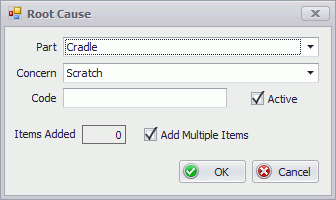What are Root Causes?
Root causes are used to determine the real reason that a defect occurred. For example, the available information on a concern might be:
|
Part |
DVD Player |
|
Concern |
Inoperative |
|
Repair Type |
Re-seat wiring connector |
While this information is beneficial, it does not get to the true reason that the DVD player did not work. That information is critical in improving the process that led to this defect.
The inspector's job is generally to find problems, but not necessarily diagnose them or try to determine root causes. The person who best knows why a problem (defect) has occurred may be the repair person during the time of repair, or an engineer who researches the problem later.
Root causes for this particular part/concern combination (up to the time the repair was made) might include:
Defective DVD Player (supplier-related)
Wiring short
Wiring connector not properly seated
Once a root cause has been created it can be assigned to part/concern combinations. See here.
Defining a New Root Cause
Select the Inspection tab.
Click Root Causes.
A list of the existing root causes and root cause folders is displayed.
Click the add icon (![]() ) below the right-hand pane.
) below the right-hand pane.
The following popup appears:

Select the required part/concern combination from the drop-down lists.
Enter a unique code (optional).
Click OK.
The Root Cause is shown in the list.
The root cause can now be assigned to a part/concern. See here.
Creating Root Cause Folders
Root cause folders are optional and can be used to organize root causes to prevent the administrator having to scroll through long lists of them. Folders also make it easier to assign root causes to a part + concern combination.
Select the Inspection tab.
Click Root Causes.
A list of the existing root causes and root cause folders is displayed.
Click the add icon (![]() ) below the left-hand pane.
) below the left-hand pane.
The folder creation window opens.
Enter a description and code.
Click OK.
The folder is added to the list.
Drag and drop concerns from the right-hand pane onto the folders in the left-hand pane to associate them.